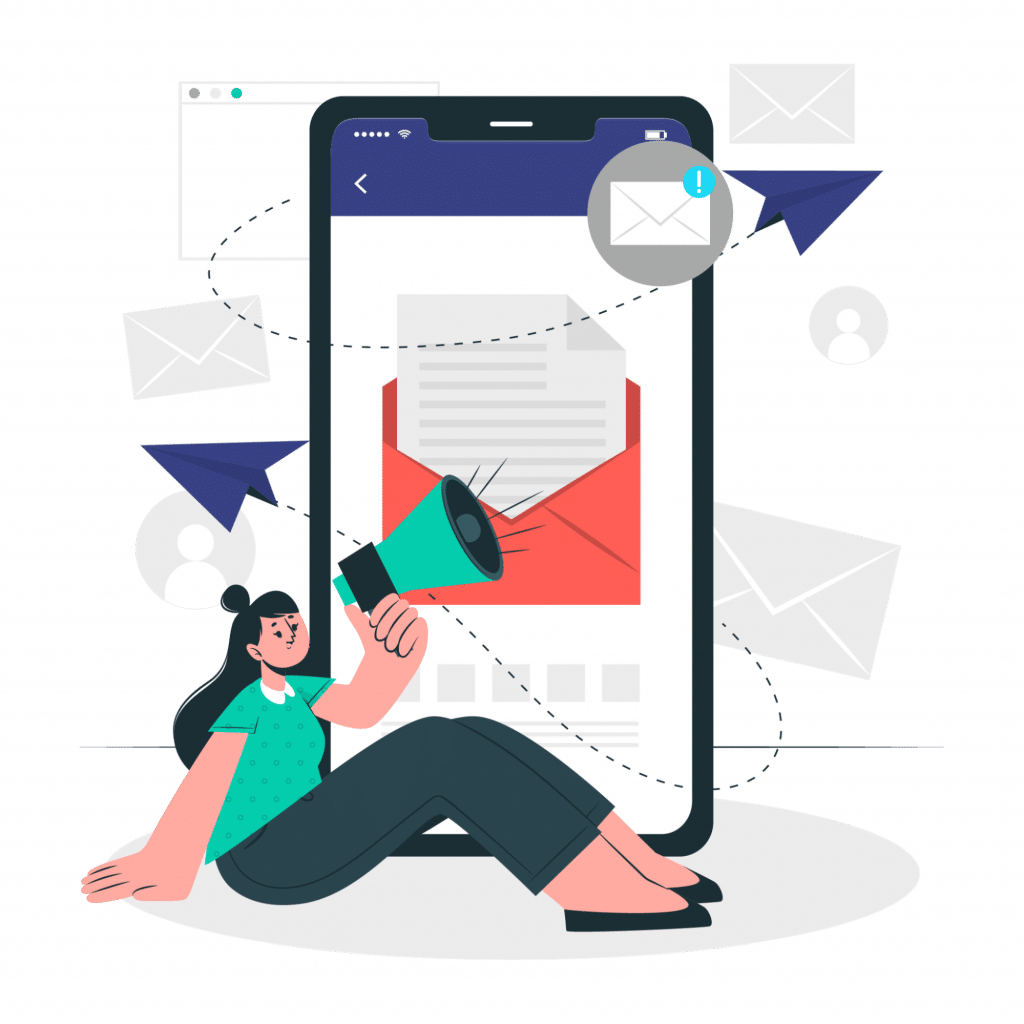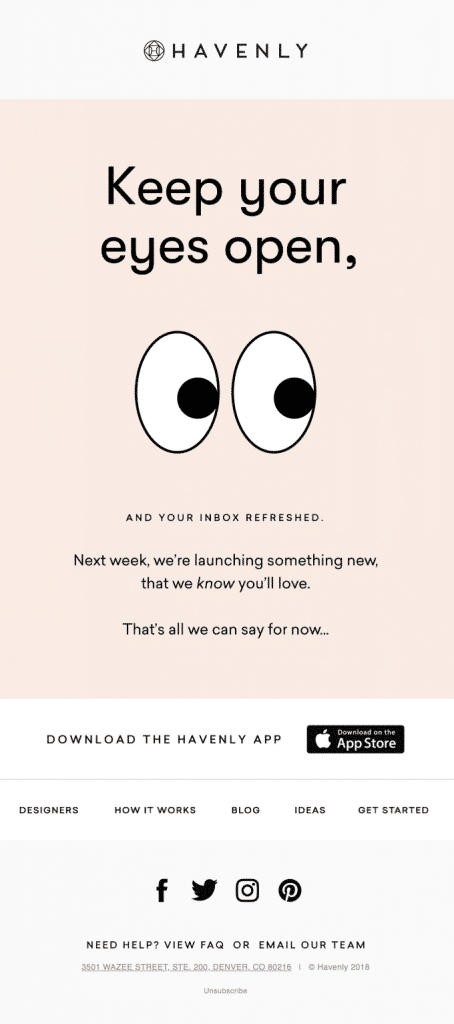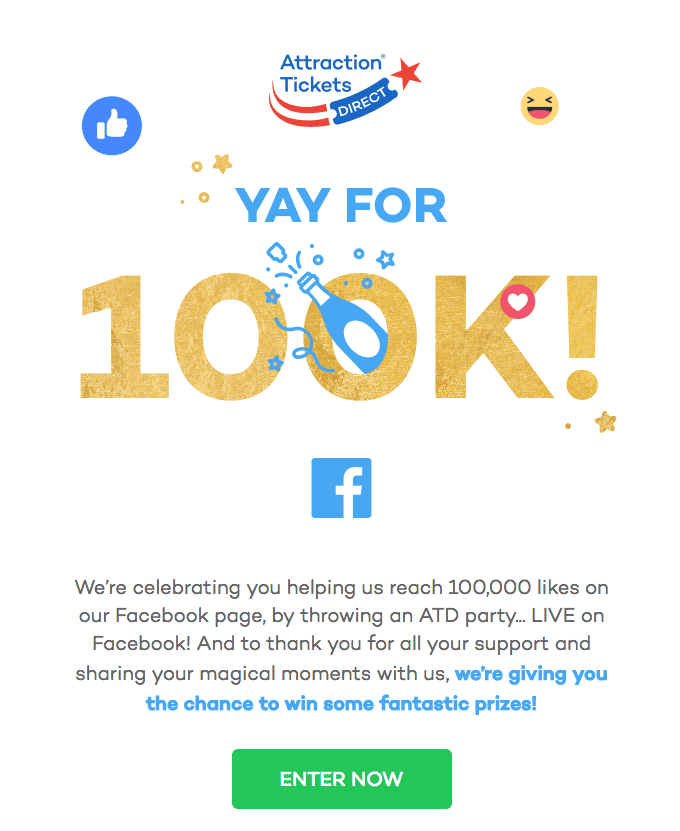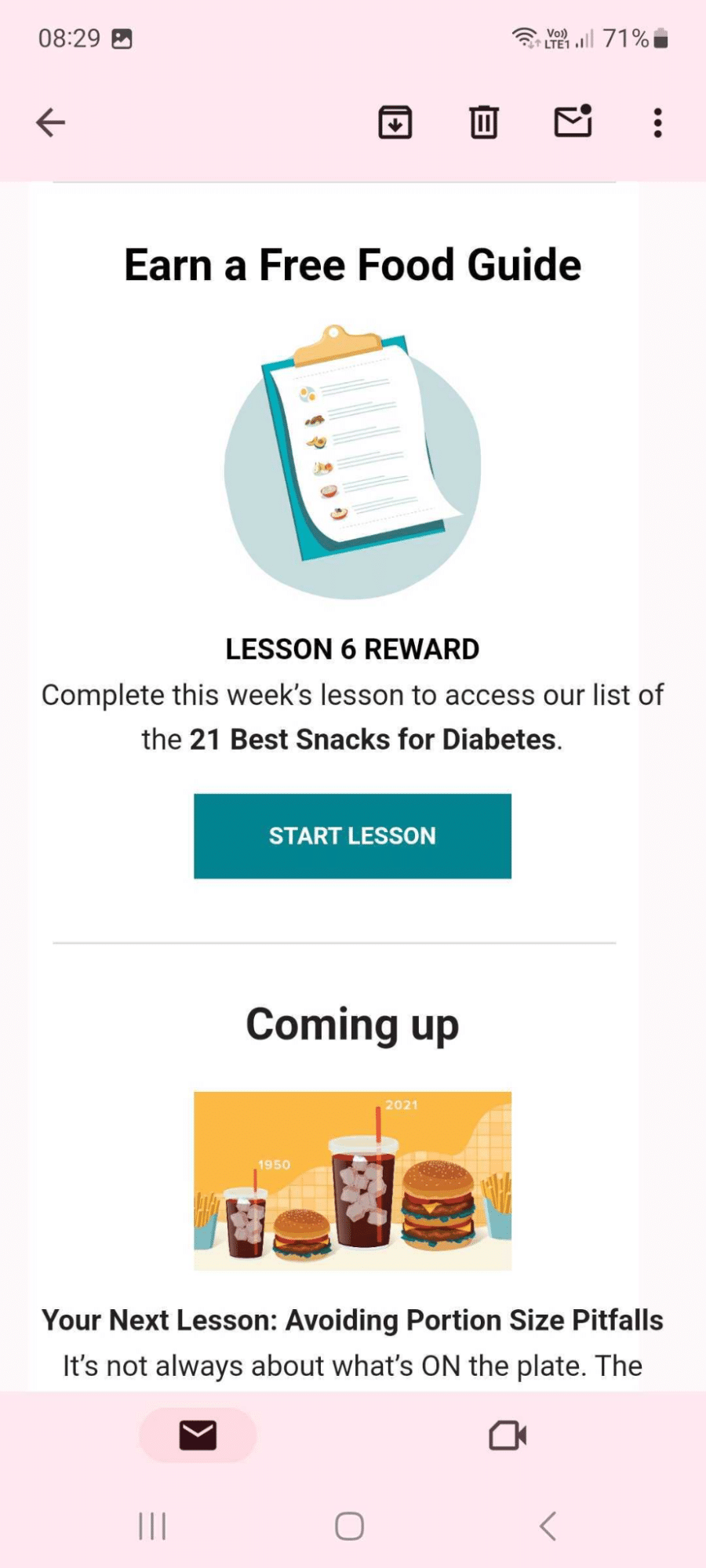
Email marketing is a crucial part of any digital strategy. With a return on investment (ROI) of $36 for every $1 spent, you can’t afford not to use email as a marketing tool for your business.
Sending marketing newsletters is a great way to nurture leads and keep your existing customers up to date with new offerings.
Additionally, email marketing is relatively easy to get right and can be highly automated with the proper tools. This makes it a worthwhile investment for your company.
However, it’s possible that both your prospects and existing customers receive hundreds of promotional emails each day. So you must use these emails strategically and find ways for your brand to stand out.
In this article, we’ll share some of the best newsletter ideas you can use to keep your subscribers engaged, boost your open rates, and achieve more conversions.
The benefits of marketing newsletters
Promote your blog or news
Announce new products
Ask for feedback
Educate the audience about your product
Run a giveaway
Send personalized recommendations
Send newsletters based on occasions
Use customer-generated content
Use quizzes
Send a video newsletter
Share industry news
Promote upcoming events
Offer how-to guides and free resources
Repurpose your social media posts
Exclusive offers
Email newsletter best practices
Newsletter mistakes to avoid
The final word
The Benefits of Sending Newsletters
There are many reasons to include email in your digital marketing strategy.
👍 Nurture leads
Email newsletters connect you directly with interested subscribers—those who’ve shared their emails are already keen on what you have to offer.
By regularly sending them tailored offers, you can turn them into long-term customers who will keep returning for more. This strategy fosters lasting connections, laying the groundwork for enduring customer loyalty.
👍 Customer retention
Email marketing isn’t only about attracting new business. It’s also a useful tool for customer retention.
You can use your newsletters to drive more purchases, send special offers to keep customers engaged, and promote new products and services when you launch them.
👍 Drive traffic to your website
Even if you’re already running an online publication like a blog, newsletters can play an important role in improving your traffic.
Statistics from sources like Vox show that visitors coming from newsletters engage with articles substantially longer, nearly tripling the time spent compared to visitors coming from Facebook.
👍 Boost your other digital marketing efforts
Email newsletters go hand in hand with your other digital marketing efforts. For example, if your business is active on social media, you can use email to grow these channels and vice versa.
When you do this, you’re also creating more opportunities for conversions and sales.
Newsletter Ideas to Get You Started with Email Marketing
Now that you know how beneficial email marketing can be for your business, let’s look at some newsletter ideas to get you started:
➡️ Promote your blog or company news
If you have a blog or online publication, sending your latest blog posts to subscribers via your newsletter can be a useful way to increase your website traffic.
Choose your favorite posts and share a preview with an image and a short snippet. You could do this each week.
Including social share buttons in your content allows your audience to easily share it with their own followers, enhancing reach and engagement.
You don’t have to limit yourself to only one blog post—your newsletter can contain several of your top posts from a certain period, with a short snippet of each of them.
That’s what Medium does with their newsletter: they send you recommendations based on the people and publications you follow to provide you with the articles you’re likely to be interested in:

If sharing blog posts isn’t an option, consider distributing a monthly business recap instead. This approach is particularly effective in the business-to-business (B2B) sector.
Your subscribers may be interested in what’s going on within your business and what they can expect from you in terms of new features or services.
Lastly, along with your company news, you might want to share some behind-the-scenes content that shows your readers what your team is currently working on
➡️ Announce new products
Your monthly newsletter is one of the best channels for new product announcements.
Your subscribers are likely already interested in your products. They’re aware of your brand, so they’ll probably need less convincing to make a purchase.
Many of your email subscribers have likely hit the “subscribe” button following a purchase, which makes them the ideal audience to promote your new products or services to.
You can even send an email before launching a new product. This way, you can prepare your audience and drive excitement around your launch. Then, you can send another email with a special offer for the first few customers.
Here’s a great example from Havenly that likely caused a real buzz among their subscribers:

➡️ Ask for feedback
Customer service newsletters are becoming increasingly popular. Asking your audience for feedback on your products or their shopping experience can be a great way to show them you care.
It can also help you identify possible issues in your process. Customers frequently provide insights on aspects you might have overlooked, highlighting areas for improvement.
This process can be streamlined by sending a simple email with a button linking to a survey, making it easy to collect feedback.
The best time to send a customer service newsletter is shortly after a customer completes an action like purchasing a product or using a service.
Here is how Lyft did it:

➡️ Educate the audience about your product
Depending on where your customers are in the sales funnel, an educational newsletter could be just what they need to help them make a decision.
Imagine this scenario: a customer just learned about you and gave you their email in exchange for a lead magnet. A lead magnet is typically a free download in return for a prospect’s email address.
The following day, you send them an email that highlights exactly what separates your product from your competition and gives them a few use cases.
While this may not make them instant customers, it has the potential to move them to the next phase in the funnel, where they’ll be more informed about your product. They may even start considering making a purchase.
Here is one example from Moon Juice that asks the question, “What makes our product different?” and directly answers it in the newsletter:

➡️ Run a giveaway
If there is one thing that can almost guarantee newsletter engagement, it’s a giveaway. Running contests with attractive prizes is a fantastic strategy to boost brand awareness and transform occasional purchasers into loyal, repeat customers.
Milestones are the perfect reason to celebrate with a giveaway. Have you reached 10,000 followers on Facebook? Is your business celebrating its 5th birthday? You can share the joy with your loyal customer base via your newsletter.
A newsletter is the best marketing channel for reaching those interested in your special offers and contests.
Here is one simple example from Attraction Tickets:

If you’d like to, you can also use your newsletters to send gifts like free trials, samples, and discounts.
➡️ Send personalized recommendations
To make your business newsletter shine, you may want to consider email personalization. Emails that are personalized achieve an open rate of over 29% and a click-through rate of 41%.
Handpicking content or special promotions to send your existing customers is a good place to start. But sending them offers that are tailored to their specific needs can really impress your recipients.
You can do this by segmenting your audience into smaller groups based on their interests, demographic data, and purchase history. You can then send these segmented audiences more personalized emails.
For example, you may have a list of male subscribers aged between 18 and 25 who are interested in your luxury shoes.
So, you know their demographic (young males), their interests (shoes), and their purchasing habits (luxury products). You can leverage this data to send them personalized offers that will capture their interest more effectively.
To spice things up and impress these customers even more, you can use hyper-personalized email elements from Hyperise.
By doing this, your customers will receive tailored messages that address them on a personal level, potentially driving better results.
➡️ Send newsletters based on special occasions
Revitalize your content approach by celebrating special occasions. Whether it’s holidays, company anniversaries, or your customers’ birthdays, the possibilities for celebration are boundless.
You could have a special discount on T-shirts on the first day of summer, for example. Or, you could offer “scary low prices” on Halloween. You can even create your own special days to celebrate with your customers.
Here is how Warby Parker celebrated the first day of spring with special color palettes:

You can also celebrate the anniversary of your customers’ sign-up on your website with exclusive offers. This can strengthen relationships and encourage repeat business.
➡️ Incorporate user-generated content
User-generated content (UGC) originates from individuals outside of your brand, such as fans who adore your products or services. You may also opt to use relevant UGC from others that aligns with your brand’s ethos.
As part of your campaigns, you can ask your followers and subscribers to take pictures, share anecdotes, and write inspirational stories that you can share with others.
We’ve seen this on social media: brands run an Instagram contest where all the users need to do is take a selfie with a hashtag, and the brand might repost them, giving them a reward in the process.
It’s possible to use a similar approach in your email marketing campaigns. Take a look at this example from Glossier:

This can show your subscriber base that you have a loyal and engaged community that cares about your brand enough to participate in your content creation process.
➡️ Use quizzes
Giving your users a chance to interact with your content is an excellent strategy on any platform, including email newsletters. Quizzes are one way to drive this interaction.
For example, Buzzfeed has managed to create quizzes like “Choose Some Potato Foods And We’ll Reveal If You’re An Introvert Or Extrovert” to get exposure for their brand.

Some email automation tools give you the option to include simple quizzes in your newsletters to increase engagement and entertain your subscriber base.
Ensure the quizzes you create make sense for both your business and your audience.
➡️ Send a video newsletter
If open rates are one of your key concerns, you might want to consider including video in your email marketing efforts.
Video is not only a highly popular format, but studies also show it can boost your open rates by as much as 6%.
👉 The Challenge with Video Content
Most email providers won’t allow users to play a video directly in a newsletter. To get around this, you can include a clickable image with a play icon that directs the viewer to your video on YouTube.
Here’s an example of a clickable video image in a newsletter by Barista Microtorrefactuer:

Videos are versatile tools that can be used at every stage of the customer journey. They can serve to educate subscribers about your products, deliver special promotionos, or even express gratitude for a purchase.
➡️ Share industry news
Your newsletter doesn’t have to pertain solely to your brand. You could also share more general industry news that would interest your subscribers.
Browse news websites and select stories that hold value for your audience. You can then create a newsletter that features this news in bite-sized chunks.
Here’s how one thought leader, Colby Kultgen, shares news that he curates from around the web with his subscribers:

Sharing industry news may not directly sell your brand to subscribers, but it establishes you as an authority in your industry. It also helps you build trust and credibility with your subscribers, as it looks like you know your stuff.
➡️ Promote upcoming events
Whether you’re sponsoring a conference or hosting an informative webinar, you can send newsletters to your subscriber base with details about the event.
You can even create a comprehensive user journey for the event, starting with a teaser and then slowly sending out more information about the occasion and getting readers excited.
Email is an excellent way to attract more people to your event, as this digital marketing platform allows you to reach audiences who would be interested in participating.
➡️ Offer how-to guides and free resources
Sharing free resources and guides is an excellent way to keep your email subscribers engaged and wanting more content from you.
Some free content you could create for your newsletter subscribers include:
- Guides on how to use your product.
- How-to information that will help them reach their goals or solve their problems.
- Downloadable informative eBooks or whitepapers.
- Templates that subscribers can use to make their lives easier.
Free items encourage subscribers to continue to engage with your brand. It also helps you build brand loyalty and can assist in nudging prospects through your sales funnel.
Here’s an example of a free resource Healthline shared with their subscribers:

➡️ Repurpose your social media posts
An important aspect of content marketing is repurposing existing content and distributing it across all your various digital channels. This helps you maximize a single piece of content that you’ve created.
Beyond distributing blog posts, you can also transform your social media content into engaging newsletters.
For example, a short social media post that comments on an industry trend could be turned into longer content for an email.
You can also repurpose older blog posts as email newsletter content, provided that they’re still relevant.
➡️ Exclusive offers
One of the main reasons people subscribe to newsletters is because they’ve been promised exclusive deals.
If you’ve gotten people to subscribe to your newsletter on this premise, it’s important that you follow through. Consider what kinds of special offers you can give your email subscribers that they wouldn’t be able to get anywhere else.
You can also use a unique coupon code in your email so that you can track which sales are coming from your newsletter subscribers.
A simple 10% off their next purchase every few months is more than enough motivation for your existing audience to stay subscribed to your newsletters.
Here’s a promotional email from Headspace for 30% off their app subscription:

Email Newsletter Best Practices
Now that you have some newsletter ideas to get you started, here are a few best practices for email marketing that you should follow:
✅ Use effective subject lines
Depending on your industry, your email open rates will likely fall somewhere between 15 and 25%. Unfortunately, this means that most of your emails won’t be opened.
However, using enticing subject lines will increase your chances of getting better open rates.
Some tips on using subject lines effectively include:
- Using personalization.
- Being descriptive.
- Limiting punctuation.
- Using emojis strategically.
✅ Keep a consistent schedule
Make sure your audience knows when they can expect to receive a newsletter. That way, you’ll build anticipation, and you’ll become a part of their weekly or daily routine.
✅ Consider mobile users
An increasing number of people are opening their emails on smartphones, so keep this in mind when creating your newsletters. Be sure to optimize your images for mobile viewing and keep headings concise to maintain the integrity of your design.
✅ Use strong calls to action (CTAs)
Whatever the goal of your newsletter campaign, make sure your calls to action (CTAs) are clear and strong.
End each newsletter with an invitation for your subscribers to take action. This could be checking out your latest offer or reading more of your articles. It’s also a good idea to personalize your CTAs with Hyperise, as this will further encourage readers to engage with your brand.
Newsletter Mistakes to Avoid
If you like the above newsletter ideas and want to get started on your own email marketing campaigns, here are some pitfalls to avoid:
❌ Constantly hard-selling your brand
There’s nothing wrong with sending the odd promotional email, but it shouldn’t be your only strategy.
Constantly hard-selling your brand is the quickest way to lose subscribers. People may be subscribed to your newsletter to receive exclusive offers, but they’re also subscribed to get the content they enjoy.
It’s important to remember that email users are usually quite particular about who they subscribe to in order to avoid getting hundreds of promotional emails every day.
To maintain your spot on their list, steer away from the hard sell and rather focus on providing content that is useful, informative, entertaining, and inspiring.
❌ Not having a clear goal
Regularly sending out newsletters is a potent content marketing tactic, yet its effectiveness hinges on having a well-defined goal for each campaign.
Each newsletter that you send should be driven by a specific purpose.
Ask yourself what the goal is before crafting your newsletter. Keep this aim in mind as you write your email.
The action you want the reader to take should be informed by your goal. Do you want them to visit your website to convert into a sale? Do you want them to download a free resource so you can capture their contact information?
Your email should be designed with the action you want subscribers to take, even if it isn’t a hard sell.
❌ Your writing isn’t relatable
Don’t forget to write your emails in a way that sounds human and relatable. Many marketers create newsletters using professional and bland language, hiding behind a brand name.
While you should be using plain language that is easy to understand and allows people to skim through your email, there’s nothing wrong with injecting a little personality into your writing.
❌ Not defining your target audience
Who are your email subscribers? Where do they live? What are their interests? Without knowing these details, creating a newsletter that captivates your readers will be difficult.
Use your email marketing platform to find out exactly who your subscribers are and tailor your email newsletters to these audiences.
❌ Failing to segment your audience
An important part of speaking to your target audience is to segment your subscribers. You need to send out content relevant to readers, and it’s impossible for one newsletter to be this for hundreds of subscribers.
To avoid people unsubscribing from your email list, it’s crucial to categorize your audience into distinct personas. Segmenting users based on criteria like age, location, and profession helps you target the right groups with content that resonates specifically with them.
❌ Forgetting to A/B test
A/B testing is when you test two or more different types of content—newsletters, in this case—to see which email performs best.
You can A/B test things like:
- Different subject lines.
- Different previews.
- The heading of your email template.
- Different CTAs.
- Different placement of CTA buttons.
- The length of the email.
The idea is to send emails to different subscribers and see which ones have the best open and engagement rates. The email that performs best is the one you should send out more often.
❌ Not monitoring your results
How will you know if your email marketing is working if you don’t take the time to analyze the results you’re getting?
Most email marketing platforms provide comprehensive analytics, offering valuable learning opportunities. Regularly analyzing these metrics can grant you critical insights into the types of content that truly engage your audience.
Once you understand your subscribers and their behavior on a deeper level, you can craft successful newsletters with excellent open and click-through rates.
Hyper-Personalize Your Email Newsletters for Success
Email users can receive hundreds of promotional emails each day. This means you have to go the extra mile to stand out from the rest in their inbox.
One way to really differentiate your brand from your competitors is to use hyper-personalization in your emails.
With Hyperise, you can create personalized text, images, GIFs, videos, and CTAs in just a few simple clicks.
This gives you a better chance of having your subscribers open your emails and take action after reading them.
Register for a free trial of Hyperise and boost your newsletters with hyper-personalization that will help you convert leads into sales and existing customers into lifelong patrons.
Last Updated on February 20, 2024